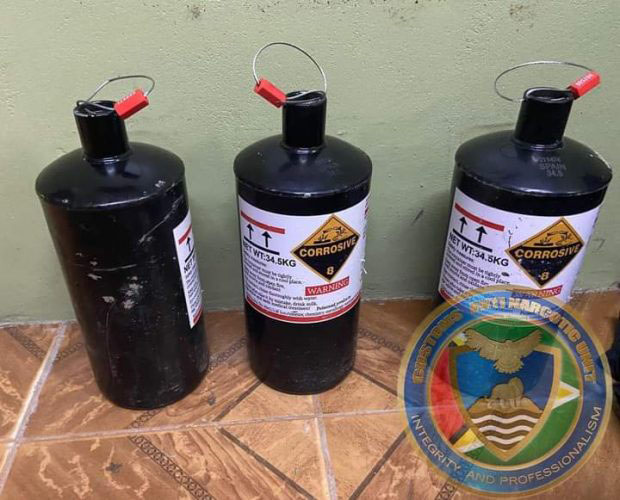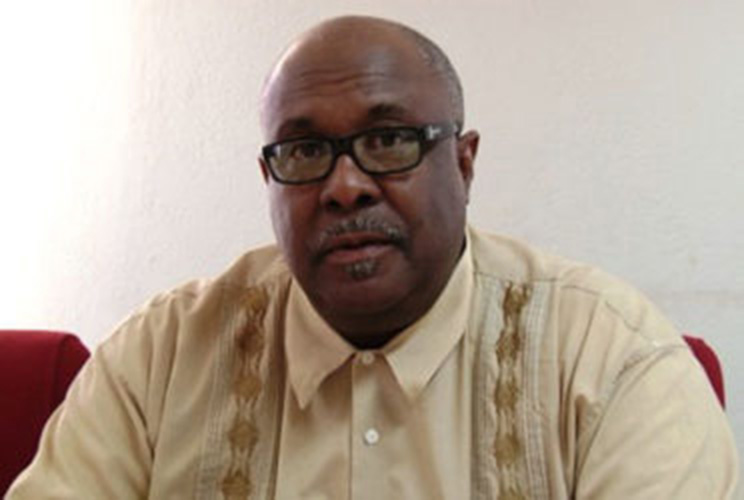-planned testing in 2021 of key alternative still to be done
The Guyana Geology and Mines Commission (GGMC) continues to face challenges from miners who insist on using the dangerous pollutant mercury to separate gold, citing its cost-effectiveness and lack of access to cheaper alternatives, Commissioner of the GGMC, Newell Dennison says.
Clamping down on mercury use here also poses major challenges for regulatory agencies due to this country’s porous borders and lack of data to ascertain how much is being smuggled in and out.
Despite these setbacks, GGMC says it will continue to push for environmentally cleaner alternatives and will begin rollout of the promised RIVEN minerals recovery system, as logistics plans were stalled due to COVID-19 and the non-delivery of the machines which were only recently received.

“Challenges [are] one, border porosity, because there is a risk of mercury being smuggled out of Guyana, and data on this issue is limited. And two, adoption of mercury-free technologies where some miners are resistant to transitioning to mercury-free technologies,” Dennison told the Sunday Stabroek when contacted last week on the issue.
“Mercury-free technology equipment is not widely available locally and securing funds for the purchase of mercury-free equipment remains a challenge,” he added.
The Minamata Convention on Mercury is an international treaty aimed at protecting human health and the environment from mercury pollution. Guyana, as a party to the Convention, is committed to reducing mercury emissions, regulating mercury use, and promoting safer alternatives
A flyover of any gold mining district across the country illustrates the damaging environmental effects of gold mining operations.
And while it is unclear how much mercury is being used in Guyana to extract gold, communities in the hinterland have complained and raised concerns about the presence of mercury pollution in the waterways, which they are reliant on for drinking and domestic purposes.
The anthropogenic effects of mercury have long been of concern. With its use largely unregulated, its entering into the environment and accumulation up the food chain, where it can cause a range of negative impacts on ecosystems and humans, have seen growing global efforts to curtail its use.
Total gold declarations for this country stood at 423,113 ounces as of December 31, 2023, while by June 30, 2024, the declarations reached 188,160 ounces, according to data from the Ministry of Natural Resources (MoNR). The ministry said that as the year progresses the declarations will increase.
However, on a breakdown for small- and medium-scale miners and respective large companies and their declarations, MoNR told the Sunday Stabroek that the disaggregated information is being collated and promised that it will be provided.
Of note is that large-scale mining company and Chinese-owned Zijin, has reported in excess of 1,949 kg of gold to government for the period up to June 30 this year.
In late 2021, MoNR and the Guyana Gold and Diamond Miners Association (GGDMA) signed an agreement for the acquisition of mineral processing technology that can increase recovery of gold and ultimately reduce the use of mercury in the form of the RIVEN system.
Pilot-tested
They had said then that the RIVEN Mineral Recovery System would have been pilot-tested for 12 months in Guyana’s mining sector and that it was part of the GGDMA’s commitment to exploring and finding effective and feasible technological solutions to improve recovery effectiveness while reducing the use of mercury in small- and medium-scale (SMS) mining operations.
That same year, Dennison had signalled that the complete ending of mercury use in local mining activities might not be possible.
Last week Sunday in an advertisement on developments in mining, the GGMC had stated that its Mineral Processing Unit continues to work tirelessly on the identification and testing of alternative gold recovery methods, aimed at improving gold recovery methods and reducing the use and instance of mercury in the recovery process. It stated that several pieces of equipment were identified and tested such as Knelson Concentrators, Shaking Tables, and Centrifugal Systems.
GGMC said also that it “has procured the RIVEN equipment, a specialised gold recovery system from Alaska, which was deemed suitable for Guyana’s mining operations. This equipment will be deployed in a suitable location to facilitate testing, which will determine its suitability to Guyana’s mineral sector.”
Last Monday’s Stabroek News editorial had questioned how the RIVEN system mentioned at the end of 2021 had not yet been tested.
Asked why only now the equipment will be deployed when it should have begun two years ago, Dennison explained that it was the GGDMA which was responsible for procuring the equipment and while they were diligent in sourcing it, delivery was severely delayed.
“The situation is, when the RIVEN was ordered, it was to be a partnership with GGDMA and the GGMC but the GGDMA were responsible for import. They had made the order but post -COVID all shipping was delayed. The actual arrival was not until recently,” he said.
“It was only recently delivered and that is why it has not yet been deployed,” he added. This was not explained in the advertisement.
Incentivising
Minister of Natural Resources, Vickram Bharrat, according to the GGMC, has stated that the government will be incentivising miners to adopt improved recovery and mercury-free technologies. He noted that the Government of Guyana through the GGMC will continue to work towards maintaining Guyana’s momentum and reaffirming the country’s global commitment towards achieving the objectives of the Minamata Convention, in a realistic manner.
Dennison said that he hopes that miners look at the long-term benefits of using mercury-free mining equipment although many argue now that it is “a convenient option and still is their go-to in terms of cost versus benefit,” he said.
Arguments put forward, he related, were that while miners understand that mercury has myriad negative effects on both their health and the environment, it is easily accessible and cheap, at a time when they are in need of providing for their families and themselves. “They look at the bread and butter aspect and argue that they can get the mercury with little money and work a week and get couple pennyweights to buy food and feed their families… it is always the cost factor and the bread and butter issue.”
In giving an overview of mercury in Guyana and progress under the Minamata Convention, Dennison said that mercury pollution here is predominantly linked to artisanal and small-scale gold mining (ASGM). “Mercury is used in these operations to amalgamate gold, which leads to the release of mercury into the environment. This has negative impacts on local ecosystems, water sources, and human health, contributing to neurological and developmental issues,” he stated.
He said that while there have been challenges, this country has however seen key achievements and progress. The “Mercury Initial Assessment (MIA) Project: Supported by the UNDP, the MIA Project was completed in November 2016. It provided a foundational assessment to inform the implementation and monitoring of mercury phase-out activities in Guyana. The findings from this project were crucial for drafting Guyana’s National Action Plan (NAP) for mercury abatement,” he outlined.
Listing development of the National Action Plan (NAP), he stated that categorized, one can see steps taken by government and the agency.
“Initiation: The development of Guyana’s NAP commenced in November 2019, funded by the Global Environment Facility (GEF) with technical support from UN Environment. Objective: The NAP aims to minimize and, where feasible, eliminate mercury releases through a phased approach, adopting environmentally sound management practices. Completion: The NAP was completed in 2021 and was officially accepted by the Minamata Secretariat in 2022,” he explained.
With regard to regulation and control measures, he said that when it comes to mercury importation, “the Government of Guyana, through key agencies including MoNR, GGMC, EPA ((Environmental Protection Agency), PTCCB (Precious Minerals Marketing Corporation), and the Guyana Revenue Authority (GRA), has established a system for regulating mercury imports. This system includes annual quotas and environmental safeguards, with a maximum annual quota of 34,500 kg for mercury, subject to gradual reduction.”
A MoU for Mercury Management between the agencies, established in August 2019, outlines joint regulatory requirements for mercury importation and management.
On Projects and Initiatives, he stated that they were many and pointed to them. “Mercury-Free Technologies: Projects have introduced mercury-free technologies to miners, such as the Gold Kacha Concentrators and Gold Cube, and promoted the use of retorts and personal protective equipment. GEF Gold Child Project: Launched in 2018, this project aims to convert Guyana’s ASGM sector to mercury-free mining by 2025, focusing on developing a mercury-free supply chain and showcasing technologies at demonstration sites of which the GGMC was the main executing body.
“Demonstrations and Training under GEF Project: Various demonstration sites have been set up to showcase mercury-free technologies, including Gold Kacha, Gold Cube, and Blue Bowl, and to train miners in their use. The project showcased mercury free technologies at three (3) demonstration sites in Mining Districts 2 (Potaro), 4 (Cuyuni) and 5 (North-west). These sites served as exemplary mercury-free gold recovery mines, facilitating the visits by other miners to observe the process and as training sites for interested miners.”
Other demonstrations done by GGMC includes its officers demonstrating to miners how the Knelson concentrator operates at Arrau, the vibrating screen and shaking table being used at Kilroy Mining Company at Eagle Mountain, Potaro, and Icon batch concentrators at Claudio Saso Mining Company at ‘Ready Money’ Middle Mazaruni River.
Monitoring and research work has also been done. “Projects have been conducted to test mercury vapour emissions and their exposure to the environment and human health in various locations such as Mahdia, Bartica, and Georgetown, and studies have determined mercury concentrations in sediments in areas like Groete Creek and Puruni,” he informed.
In relation to mercury waste management, he said too that projects are exploring practical solutions for mercury waste disposal, considering national contexts and constraints.
A case for evaluating the effects of ASGM mining on environmental media across South Central Guyana has also been launched. The project is a research collaboration between the GGMC and Trent University in Canada.
Then there is the “Piloting Mercury Passive Samplers (MerPAS) for Air Quality Monitoring” project in Bartica which uses passive sampling techniques to monitor mercury levels over time and is also part of the new technologies and standards that has passive sampling.
Dennison said that in addition, there are ongoing joint monitoring exercises with the EPA at gold shops and these are being extended to all mining districts.
“Efforts are being made to establish mercury emission standards with the Bureau of Standards,” he also announced.
In 2015 the GGMC had announced that it would activate a $1 billion revolving fund to examine and test mercury-free gold mining equipment but it is unclear what happened with that project. However, since then, the GGDMA had said that its small miners had bemoaned the costs since most of the equipment “is expensive” while citing costs of the equipment of over US$100,000, which small miners at that time could not afford.
Dennison said that Guyana has nonetheless made significant progress over years in addressing mercury pollution through various projects and initiatives under the Minamata Convention. “The development and implementation of the National Action Plan, regulatory measures, and technological advancements, demonstrate the country’s commitment to reducing mercury use and its environmental and health impacts. Continued efforts are necessary to overcome existing challenges and ensure the successful transition to a mercury-free gold mining sector,” he said.
Canisters of mercury found in August 2022 by the Customs Anti-Narcotic Unit at an abandoned sawmill in Berbice.






